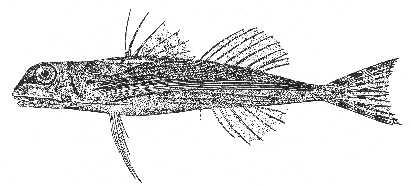Flying Gurnard Dactylopterus volitans (Linnaeus) 1758
[Jordan and Evermann, 1896-1900, p. 2183, as Cephalacanthus volitans (Linnaeus)]

Figure 248.—Flying Gurnard (Dactylopterus volitans), Key West, Florida. From Jordan and Evermann. Drawing by H. L. Todd.
Description—
The flying gurnard (only known representative of its family), built, in general, on the "sea robin" plan, is remarkable for its enormous pectorals. When it is about half grown or older, these reach nearly to the base of the caudal fin if laid back. When spread, they have the form of enormous rounded fanlike wings. Other conspicuous [page 473] respects in which the flying gurnard differs noticeably from its relatives, the sea robins, are that the first five or six rays of each pectoral, with their interconnecting membrane, form a separate fin, having no connection with the remainder of the pectoral except at the base; that the few lowermost rays of each pectoral fin are not separate, in the form of feelers, but are continuous with the remainder of the fin; that the first two spines of the dorsal fin are separate, that the bony armor covering the front and top of the head reaches rearward considerably beyond the origin of the dorsal fin on either side to end in a stout spine, that each gill cover[72] is extended rearward as a stout spine about as far as the axil of the pectoral fin, and that the scales are much larger and each armed with a short stout spine.
Color—
This is a very brilliant fish, varying widely in color; most of them are of some shade of brownish to greenish olive above, with the lower side paler, but marked irregularly with reddish salmon or salmon yellow. The winglike pectorals are variously marked with bright blue streaks near their bases, with blue spots and bars toward their tips. The caudal fin usually has about three brownish-red cross bars.
Size—
To about 12 inches.
General range—
Tropical to warm temperate latitudes of both coasts of the Atlantic; south to Brazil and north rather commonly to North Carolina on the American coast; a few to New York and the southern coast of Massachusetts in most years (in autumn[73]); recorded as a stray from Massachusetts Bay. A dried and hardened specimen that was found on the shore near Country Harbor, Nova Scotia, in September 1939, by Stanley McKinley, among the kelp and eel grass that had been washed ashore during the night, was thought by him (no doubt correctly) to have been carried north on the deck of some steamer from the south.[74]
Occurrence in the Gulf of Maine—
The only report of this warm-water fish from north or east of Cape Cod is of one said to have been taken in Massachusetts Bay.[75]
[72] Actually the preopercular bone.
[73] The most recent record from Woods Hole, of which we have heard, is of two taken there on November 24, 1948, from the deck of Albatross III while she was moored at the dock (Arnold, Copeia, 1949, p. 300).
[74] McKenzie, Proc. Nova Scotian Inst. Sci., vol. 20, 1940, p. 44.
[75] This specimen is now in the Museum of Comparative Zoology, to which it was transferred from the Boston Society of Natural History. There is no clue to its origin, except that it was taken many years ago.